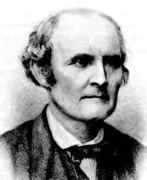Person: Cayley, Arthur

Arthur Cayley's most important work was in developing the algebra of matrices and work in non-euclidean and n-dimensional geometry.
Mathematical Profile (Excerpt):
- Arthur spent the first seven years of his life in St Petersburg where he came in contact with several languages, particularly Russian, English and French - the international business language there was French.
- Arthur showed great skill in numerical calculations at a private school in Blackheath and, after he moved to King's College School in 1835, at age 14 rather than the usual age of entry of 16, his aptitude for advanced mathematics became apparent.
- In 1838 Arthur began his studies at Trinity College, Cambridge, having George Peacock as tutor in his first year.
- Cayley graduated as Senior Wrangler in 1842 and won the first Smith's prize.
- After the examinations, Cayley and his friend Edmund Venables led a reading party of undergraduates to Aberfeldy in Scotland.
- For four years Cayley taught at Cambridge having won a Fellowship and, during this period, he published 28 papers in the Cambridge Mathematical Journal.
- In 1844 Cayley, along with his friend Edmund Venables, made a trip to the Swiss Alps, also visiting Italy.
- The Cambridge fellowship had a limited tenure, since Cayley was not prepared to take Holy Orders, so he had to find a profession.
- While still training to be a lawyer Cayley went to Dublin to hear William Rowan Hamilton lecture on quaternions.
- Cayley was a good friend of Hamilton's although the two disagreed as to the importance of the quaternions in the study of geometry.
- Another of Cayley's friends was James Joseph Sylvester who was also in the legal profession.
- Cayley and Thomson were also good friends.
- About a year after he began legal training Cayley began a correspondence with Thomas Kirkman.
- He spent 14 years as a lawyer but Cayley, although very skilled in conveyancing (his legal speciality), always considered it as a means to make money so that he could pursue mathematics.
- Cayley maintained contact with Cambridge and from serving as Senior Examiner at the annual Trinity College examinations, he progressed to the responsibility of being Senior Moderator for the Mathematical Tripos in 1851 and Senior Examiner in 1852.
- In 1863 Cayley was appointed Sadleirian professor of Pure Mathematics at Cambridge.
- This appointment involved a very large decrease in income for Cayley who now had to manage on a salary only a fraction of that which he had earned as a skilled lawyer.
- However Cayley was very happy to have the chance to devote himself entirely to mathematics.
- Cayley was to more than fulfil these conditions.
- In 1864 Cayley purchased Garden House, Little St Mary's Lane, in Cambridge.
- On 8 November 1863 Cayley gave his inaugural lecture Analytical geometry - Introductory lecture.
- As early as 1849 Cayley had written a paper linking his ideas on permutations with Cauchy's.
- In 1854 Cayley wrote two papers which are remarkable for the insight they have of abstract groups.
- At that time the only known groups were permutation groups and even this was a radically new area, yet Cayley defines an abstract group and gives a table to display the group multiplication.
- He gives the 'Cayley tables' of some special permutation groups but, much more significantly for the introduction of the abstract group concept, he realised that matrices and quaternions were groups.
- Cayley developed the theory of algebraic invariance, and his development of nnn-dimensional geometry has been applied in physics to the study of the space-time continuum.
- Cayley also suggested that euclidean and non-euclidean geometry are special types of geometry.
- In 1883 Cayley became President of the British Association for the Advancement of Science.
- In his presidential address Cayley gave an elementary account of his own views of mathematics.
- Two descriptions of Cayley, both of him as an old man, are interesting.
- The room was small, and some twelve mathematicians were assembled round a table, among them was Prof Cayley ...
- At the close of the meeting Cayley gave me a cordial handshake and referred in the kindest terms to my papers which he had read.
- Sylvester told me he never saw him angry but once, and that was (both were practicing law!) when a messenger broke in on one of their interviews with a mass of legal documents - new business for Cayley.
- In an access of disgust, Cayley dashed the documents upon the floor.
- In addition to the Copley Medal we mentioned above, we note that Cayley was elected a fellow of the Royal Society in 1852 and received their Royal Medal in 1859.
- A crater on the moon is named for Cayley.
Born 16 August 1821, Richmond, Surrey, England. Died 26 January 1895, Cambridge, England.
View full biography at MacTutor
Tags relevant for this person:
Algebra, Astronomy, Geometry, Group Theory, Origin England, Physics, Puzzles And Problems, Topology
Thank you to the contributors under CC BY-SA 4.0! 

- Github:
-

- non-Github:
- @J-J-O'Connor
- @E-F-Robertson
References
Adapted from other CC BY-SA 4.0 Sources:
- O’Connor, John J; Robertson, Edmund F: MacTutor History of Mathematics Archive
